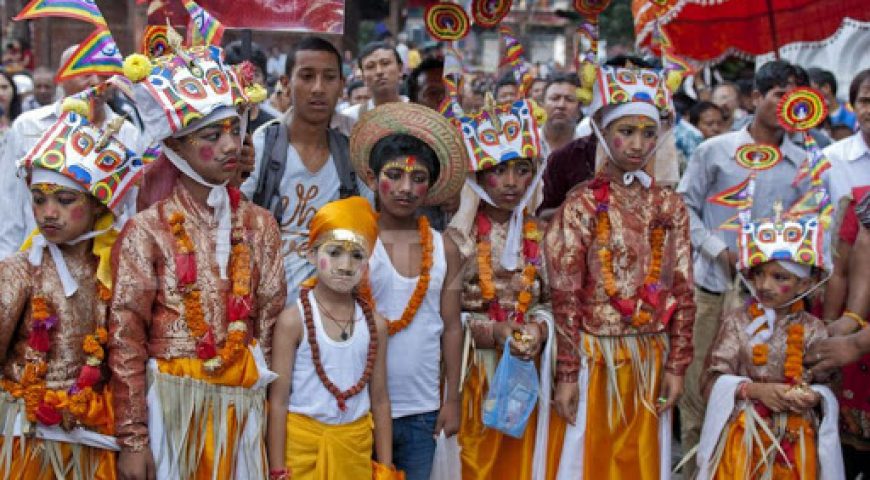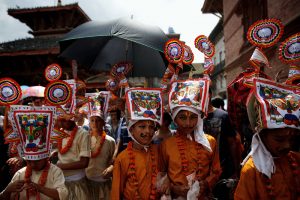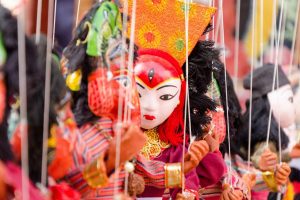
Gaijatra
Gaijatra is a festival celebrated by the local Newar community inhabiting the inner Kathmandu, Patan, Kritipur, Bhaktapur and the peripheral regions. The locals believe this festival helps appreciate the affirmative within the cynical. Humour, sarcasm and mockery serve as the highlights of this event, which are assumed to help the living celebrate the afterlife of their departed beloved. Immense make-up, joyous and loud music, mask dances, weird costumes, alcohol, crowded streets and many more notions signify the hype of Gaijatra.
In Bhaktapur, the festival lasts a week and the first day features the entertaining and furious stick dance, known as ‘ghintangghisi’, derived from the rhythmic structure of the drums. The dancers and musicians of the group who participate in the jatra move according to this pattern of ghintangghisi, thus, the routine itself is named after this musical arrangement.

Why is Gaijatra Celebrated?
The festival’s name is Gai Jatra (literally meaning the festival of cows) and nowadays it is a fusion of three traditions that came into being in three different periods of time. The first and the oldest tradition incorporates a cult and a worship of the ancient god of death – Yamaraj. Thus, the festival marks the acceptance and celebration of death in a positive way, as an inevitable part of life. Every family who has lost a member, in the previous year, is supposed to lead a carefully and intricately decorated cow through the city. In the absence of a cow, a boy dressed as a cow (the oldest for a lost male memberand the younger for a female) can successfully take on the role.
Tradition Behind Gaijatra
The event occurred when King Pratap Malla of Kathmandu lost his child, and his wife entered a tragic depression. Thus, in this great despair, he promoted this tradition of remembering the lost souls, in order to show his queen that it was not only a calamity faced by their child but an inevitable truth for all.
During the festival, the cow procession was brought before the devastated queen, and the participants, in an attempt to make the queen smile, began making a mockery of the important people in society. Through continuous humorous efforts of emphasizing and mercilessly attacking social injustice and important/corrupt social roles, the queen could not resist further and smiled. Thus, the king instituted a tradition of including jokes, satire and mockery into the Gaijatra celebration.
In Bhaktapur, a triangular-like shape, labeled as ‘gai’, is raised in representation of the dead, from each family losing a member within a year. The picture of the dead person is hung in front of the ‘gai’ and a colorful cloth is used to cover the wooden triangle for the male, and for the female, the hakupathasi, the traditional Newari fabric, is used. Music plays an important role as the ‘gai’ is taken through the city’s ritual route, visiting shrines and temples on the way, stick dancers full of weird make-up and a bundle of musician’s back-up the entire procession.
The house raising the ‘gai’ assembles the dancers and musicians and feeds them throughout the day. Different types of musical ensembles can be seen during Gaijatra – flute and drums ensemble, ensembles of just drums, i.e. lalakhi, chisya, bhusiya, dha, brass band ensembles, groups of tabla, harmonium and singers, and many more.

When to Celebrate?
It often falls in Nepali Bhadra month (August to September in Solar Calendar) and continues for eight days.
